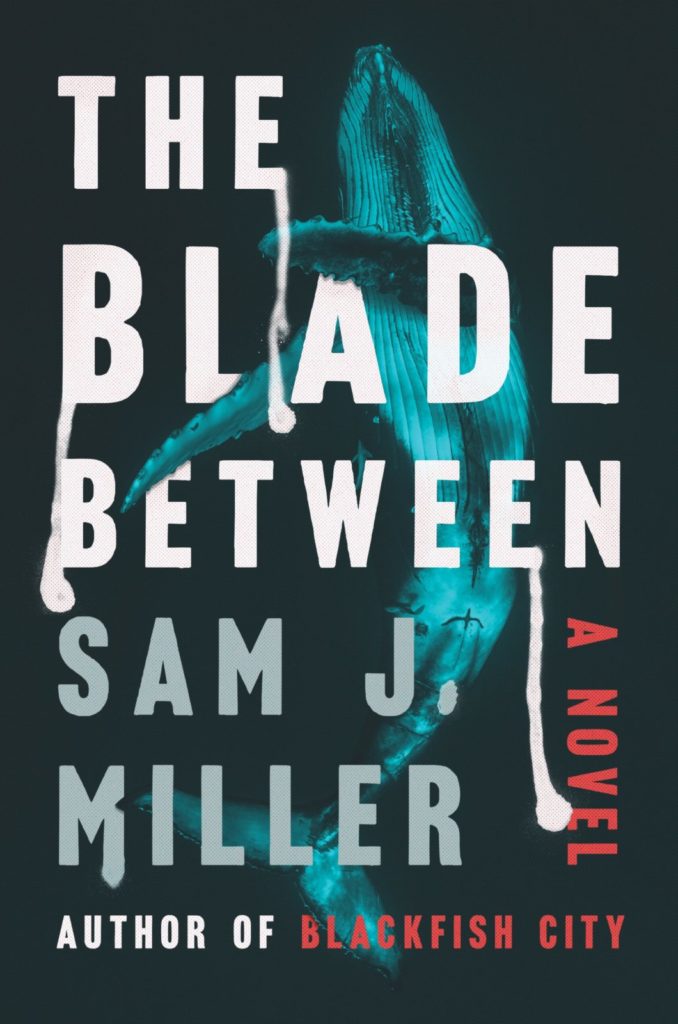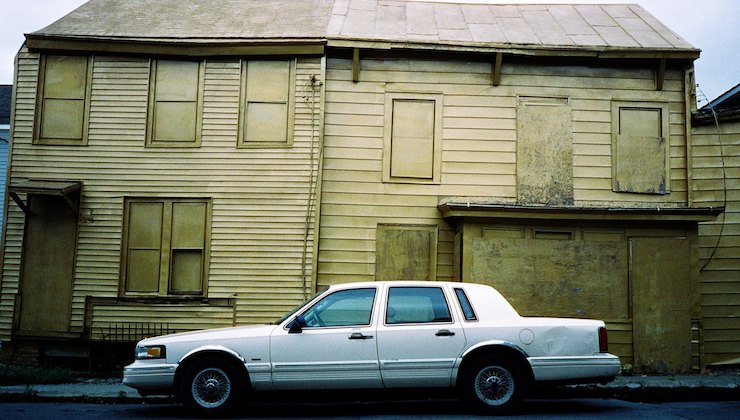The Blade Between, Sam J. Miller’s ruthless new urban gothic noir novel, keeps most of its weirdness in the background, and it’s all the scarier for it. Miller keeps the focus on the battle between Hudson, New York’s poor residents and the richer “invaders” gentrifying the city and forcing people out of their homes, mainly as a conflict between humans, restraining the presence of this universe’s old gods and monsters to whispering in the right ear or giving the right person a push. It gives the story a more grounded feel, less about the monsters and more about what the right people will do in the right circumstances, because the right person is capable of anything.
This tactic also humanizes the antagonists in the story a lot more, making them less irredeemable and more empathetic (though not always sympathetic, especially in the case of Zelda and Treenie) because they’re being manipulated, puppeteered, and, in some cases, snapped in half by cosmic forces who only care about things like “hate” or “the safety of a former whaling town in upstate New York.” This focus on the individual also gives the story a good deal of grit, creating a small-town noir that blows up into full blown gothic folk horror as each violent event and new cult faction forms. It’s a dark, downbeat, suspenseful ride, and offers a much-needed fresh spin on the gothic, folk horror, and horror-noir genres, making it the perfect read for a season when everything is much colder and darker.
Ronan Szepessy is coming home. He never thought he would, since the small town of Hudson, New York never held much appeal to him. It was a place that greeted him with homophobia and hate, a place marred by his ailing father and his mother’s untimely death, full of backwards locals and people he disliked. But as his photography gigs and his life in New York City start to go south, he’s invited back to his hometown by a model who wants to do some work and makes the trip back to the town he thought he knew.
But in Ronan’s absence, Hudson has changed. The local shops are being replaced by high-end antiques stores, a wealthy internet developer is buying up the town in preparation for a new multimillion dollar real estate development, and the locals are being squeezed further and further into poverty. Bored, still seething with hatred for his hometown, and feeling uncharitable towards the newcomers shoving his former friends and neighbors out of their homes, Ronan joins up with his childhood friends to embark on a campaign of dirty tricks against the new money flooding into Hudson. But what starts as a movement centered on vandalism, catfishing, and other skullduggery soon attracts the attention of older, more powerful forces with their own designs on the town and its people. Forces that, with just the right nudge, can cause the town to spiral into chaos. Hudson is waking up once more, quite possibly for the last time.

The monsters of The Blade Between don’t actually do much on their own, and that’s what makes the book all the more terrifying. Sure, the thing that calls itself “Tom” does a lot to mess with the townspeople and cause death and destruction, but he also acknowledges that he needed Ronan to wake him up and give him a body to wreak havoc in. The whale-ghosts who are nudging Ronan and the various other townspeople to do their bidding similarly say all they can do is push people (though “sometimes people break,” resulting in horrifying episodes of suicide and self-immolation). But while they certainly influence events and cause them to go horribly out of control, at the same time they’re not responsible for any of the things the anti-gentrification faction do, they’re just responsible for making them worse.
As the situation spirals out of control, what keeps the book terrifying is that these are ordinary people reacting to worsening situations, indulging in the worst parts of their personalities because they feel like they’ve been pushed far enough to justify it. Sure, the monsters profit, and if it wasn’t for “Tom” and the whales, then the cataclysmic destruction and the birth of a harpoon-toting whale cult likely wouldn’t have occurred, but it still comes back to the people doing all the awful things. Miller also keeps the people of the town front and center, with the supernatural elements taking a backseat, occasionally appearing in dreams or a sudden deluge of seawater, or as ghosts rather than overt threats.
The lack of overt supernatural threats and the shifting point of view that alternates between chapters of Ronan in first-person and chapters showing the lives of various Hudsonites also confers a sense of empathy and understanding to the proceedings. Ronan and Attalah, two of our central protagonists, might have started a campaign of vandalism, guerilla PR, and blackmail, but once it’s clear what they’ve done, they spend the rest of the book trying to figure out how to atone for their actions and pull Hudson back from the brink. Some of the gentrifiers and the hipsters might be invaders, pushing a specific type of class oppression, but when confronted with their misdeeds, they genuinely try to make amends and fix their mistakes rather than continue down that path. If there’s any actually irredeemable character, it’s probably Zelda, an early adopter of Ronan and Attalah’s movement who is responsible for most of the terrible events and deaths in the book, but even then, she’s more “nudged” by the whales and Tom to a point that she breaks, and then just does what comes naturally to her. Everyone’s responsible for the carnage in Hudson, but everyone has a little light to them as well.
The book also has an excellent sense of tension and darkness. As things ramp up, there’s a tension that grows, but it doesn’t necessarily explode. Each episode of violence only manages to up the stakes, keeping the clock ticking until the conflagration both sides have planned for the annual Winterfest. As the city explodes into chaos, it still feels like something’s coming, like the worst is yet to happen as of yet. Things start out subdued, with everything bubbling under the surface, but then slowly wind up with each incident, each violent moment and bizarre strike against the “invaders” of Hudson only further ratchet up the stakes and tension until people are killing each other with harpoons in the street. Despite its posh new appearance, Hudson also has a lot of grit to it, with Miller focusing not on the gilded facades, but on the people pushed aside to make them possible. It’s a look at gentrification not from the aesthetically-pleasing outside, but from the actual consequences of the world, and adds a certain grit to the darkness.
The Blade Between is an excellent horror-noir, blending a unique eldritch mythos, the pastoral “small incidents lead to large conflagrations” pacing of Needful Things with a much tighter plot, and the grit and punch of small-town crime novels into a brutal, bleak, feverish depiction of the battle for Hudson’s soul. With its sympathetic characters, rich atmosphere, and tense pacing, it winds itself up tightly, a series of highs and lows that never lets up until the final plunge into total chaos at the climax. It’s an urban gothic novel with the perfect amount of dread and horror, and it’s the perfect read for these cold winter nights.



